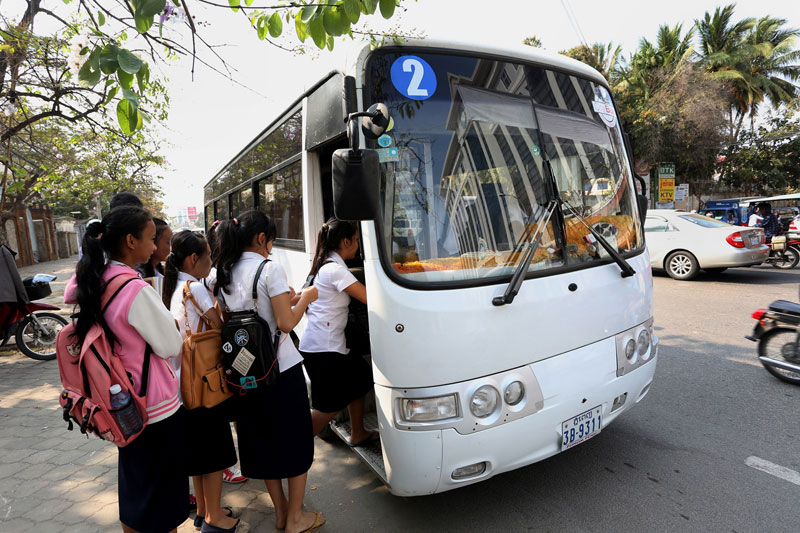Ten buses set off Wednesday morning along Monivong Boulevard in Phnom Penh on a month-long test-run to determine if the public is ready to jettison their motorbikes and luxury cars and hop on board mass transport.
This is the second attempt by the Japanese International Cooperation Agency (JICA) and the municipal authorities to address traffic congestion by establishing a public bus service, following a two-month trial in 2001 that was terminated due to public indifference.

After reporters waited in vain for one hour between 5.30 a.m. and 6.30 a.m. for the first scheduled bus to arrive at the stop beside Phnom Penh Tower on Monivong Boulevard, it was easy to assume that City Hall was about to bungle yet another attempt at a public service.
But a quick ride on a motorcycle taxi to the bus route’s starting point at the “Old Stadium” roundabout revealed that a last minute change of plans had postponed the rolling-out time of the buses.
“City Hall delayed the start time as the opening ceremony is important to help disseminate information about the service to the public,” JICA spokesman Egami Masahiko explained of the late arrival of the first bus.
At the start point, Phnom Penh Governor Pa Socheatavong told the crowd of about 100 mostly local government officials, with a smattering of curious onlookers, that City Hall was determined to ensure the success of the city bus service this time around.
“If there is only a trial and the operation is then ended, it will have been meaningless,” he said, adding that the 36-stop trial route from the “Old Stadium” roundabout to Chbar Ampov across the Monivong Bridge is just one of five planned routes in the city.
“More than $300 million is lost annually due to traffic accidents in [Cambodia], which is devastating and a tragedy for our city…so I appeal to people to start changing their attitudes and support this project,” he said to launch the bus service.
As the attendees clambered on board the first two buses and media fought to photograph officials purchasing 1,500 riel (about $0.35) bus tickets, the enthusiasm for the first bus ride was evident.
“It can definitely succeed,” a grinning deputy municipal governor Khuong Sreng said from the open window of the Number 1 bus.
“Ten years ago, we did not have such a problem with traffic congestion, but in the past few years we are experiencing a lot, so I think people will turn to public transport,” he said.
The first two buses took off at about 8.40 a.m.—stopping a short distance later at City Hall to permit the government officials to disembark.
On the leisurely one-hour journey onward to Chbar Ampov, paying passengers mostly failed to materialize, though it was admittedly early in the day and bus stops did attract small crowds as the day wore on.
The only passengers on the inaugural journey were two 19-year-old students from the Royal University of Law and Economics, who were optimistic despite the absence of traveling companions.
“I will take the bus to school because it is comfortable, safe and cool, and I can even read books on the way,” said Ly Sodavid.
His classmate, Vanneth Sambath, said he anticipates passenger numbers will grow.
“This is my first time taking a public bus, and if the service expands into different routes I imagine my friends will take the bus to school too.”
The main goal of the trial is to identify areas that need improving before the service is expanded, such as placing lights at dark bus stops to protect the safety of passengers, said Mr. Masahiko, the JICA spokesman.
“It may be difficult to see a decrease in traffic volume as we cannot stop the number of cars and bikes increasing, but it is a very good first step because a huge city needs a public transport system.”




